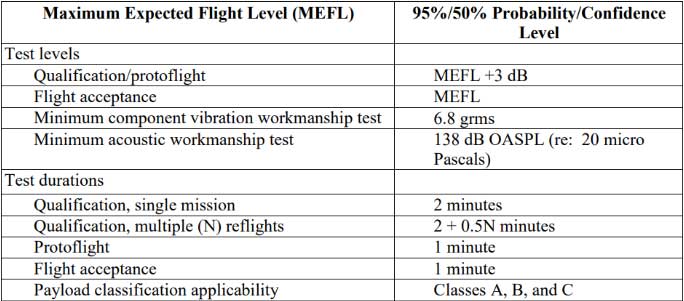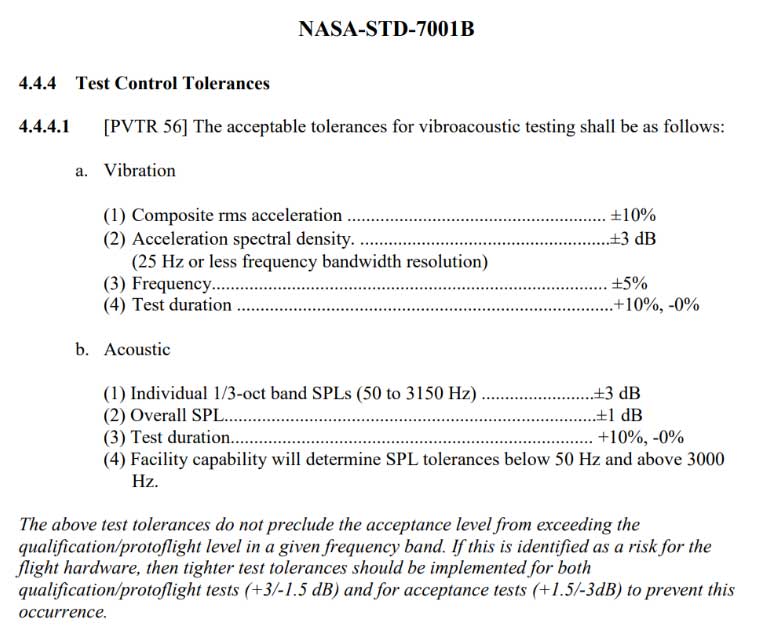The NAS ASTD 7001 Vibration Testing standard is a uniform regulation of vibration test methods for aerospace payload hardware published by NASA, which defines vibrational acoustic activity as a high level of acoustic noise generated during flight that affects the payload in the form of acoustic excitation or random vibration. NASA STD 7001 is limited to space payload hardware, meaning items carried by spacecraft, such as satellites, spacecraft, or observatories.
These standards provide test factors for payload hardware verification for prototypes, prototype flights, and flight acceptance procedures. Topics covered include:
The NASA STD 7001 standard specifies the Level of acoustic and random vibration testing associated with the Maximum Expected Flight Level (MEFL). These test levels determine the severity of the shaker table vibration testing.
The standard also includes duration requirements for vibration tests and control tolerances for various test parameters

The NASA STD 7001 standard specifies the corresponding tolerance requirements for vibration acoustic testing. These tolerances help ensure that vibration tests are maintained at the right level.
For example, if the measured value of the vibration control channel exceeds the allowable range specified in the standard, the vibration controller immediately adjusts the driver output until the input signal is restored to the appropriate level.
According to the NASA STD 7001 standard, almost all electrical, electronic and electromechanical components and mechanisms are required to undergo shaker table vibration testing. However, structures with more area than weight can use acoustic testing instead of random vibration testing, while hardware that does not actually produce component-level vibration, such as structures, cables, pipes, and insulation blankets, can be deferred to system-level vibration or acoustic testing.
For compact payloads weighing less than 450 kg (1000 lb), a system-level random vibration test should be performed unless the analysis shows that the response of the payload is primarily affected by the immediate acoustic environment. In the random vibration test, the test sample should be subjected to random vibration with Gaussian amplitude distribution on three orthogonal axes.
Random vibration testing should be performed by controlling the acceleration spectral density (g^2/Hz) in the frequency range 20 to 2000 Hz. The spectrum shall be within the test tolerance specified in the standard. If multiple control accelerometers are used, an average or limit control scheme can be used to control the test level, but the controller must be determined according to the test requirements.
Before the test begins, the bare fixture should be tested for resonance in a frequency range up to 2000 Hz. If feasible, the fixture should not resonate in the test frequency range. When the test sample is mounted on the fixture, its actual flight or equivalent mounting mode should be simulated.
Each of the three orthogonal axes of the vibration test is 1 minute. For subsequent spacecraft hardware and spare parts, the acoustic test acceptance test time should be 1 minute, and the vibration test should be 1 test clip. Every minute on the three orthogonal axes. In other cases (e.g., retesting of flight hardware), the test conditions will be determined by applying a random test curve arranged in the breakpoint table, which includes frequency (Hz) and amplitude (G2/Hz) values, as well as the crossover slope (dB). Power spectral density (PSD) diagram shows the values; The change of PSD level is measured in dB.

JOEO is a leader in China’s Vibration shaker manufacturers, we actively participate in national projects, in vibration, shock, hydraulic, data acquisition, fatigue, modal, rotary table, sensing, intelligent vibration reduction, measurement calibration, aero-engine special test equipment and other products innovation achieved fruitful results, More than 80 core technologies and patents for environmental and mechanical property evaluation and reliability solutions.
Our vibration shaker have the following features:
Our Vibration shaker comply with test standards such as NASA STD 7001, NASA STD 7002, RTCA DO-160 and are suitable for various industries and provide solutions to customers free of charge
Submit the form below to discuss with our experts
